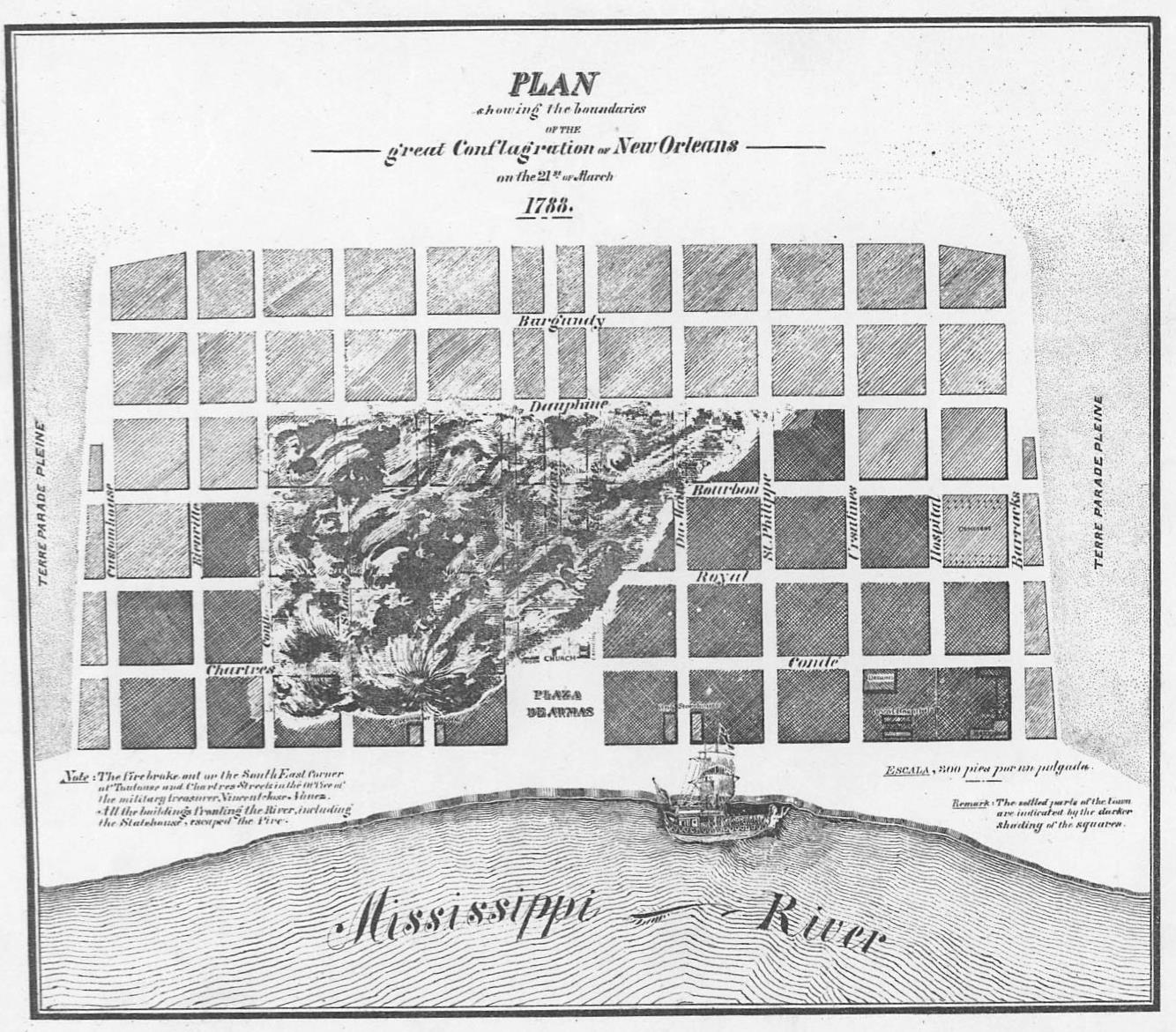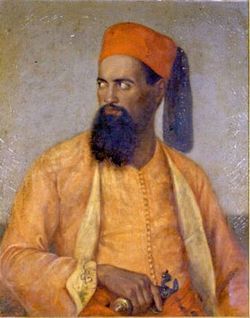|
|
|
The Great New Orleans Fires
|
The great New Orleans Fires of 1788 and 1794
|
.
The Great New Orleans Fire (1788)
was a fire that destroyed 856 of the 1,100 structures in New Orleans, Louisiana on March 21, 1788,spanning the south central French Quarter from Burgundy to Chartres Street, almost to the riverfront buildings. An additional 212 buildingswere destroyed in the Great New Orleans Fire (1794) on December 8, 1794.[1]
History
The Good Friday fire started about 1:30 p.m. at the home of Army Treasurer Don Vincente Jose Nunez, 619 Chartres Street at Toulouse Street, less than a block from Jackson Square (Plaza de Armas), and within five hours consumed almost the entire city fed by a strong wind from the southeast. The fire destroyed the original Cabildo and virtually all major buildings in the French Quarter including the city's main church, the municipal building, the army barracks, armory, and jail. Only two fire engines were operational and they were destroyed by the fire. Louisiana Governor Esteban Rodríguez Miró set up tents for the homeless.
The fire area stretched between Dauphine Street and the Mississippi River and between Conti Street in the south and St. Philip Street in the north. It spared the Mississippi River front buildings. Among the buildings spared was the Customs House, the tobacco warehouses, the Governor's Building, the Royal Hospital and the Ursulines Convent.
The Spanish were to replace the wooden buildings with structures with courtyards, thick brick walls, arcades, and wrought iron balconies. Among the new buildings were the signature New Orleans buildings of St. Louis Cathedral, the Cabildo and the Presbytere.
| |
After just 6 years of rebuilding, on December 8, 1794, another 212 buildings were destroyed in the Great New Orleans Fire (1794). Still a colony of Spain, rebuilding continued in Spanish style, and most French architecture was eliminated from the French Quarter.
-
If the imagination could describe what our senses enable us to feel from sight and touch, reason itself would recoil in horror, and it is no easy matter to say whether the sight of an entire city in flames was more horrible to behold than the suffering and pitiable condition in which everyone was involved.
-
-
Mothers, in search of a sanctuary or refuge for their little ones, and abandoning - their earthly goods to the greed of the relentless enemy, would retire to out-of-the-way places rather than be witnesses of their utter ruin. Fathers and husbands were busy in saving whatever objects the rapidly spreading flames would permit them to bear off, while the general bewilderment was such as to prevent them from finding even for these a place of security.
-
-
The obscurity of the night coming on threw its mantle for a while over the saddening spectacle; but more horrible still was the sight, when day began to dawn, of entire families pouring forth into the public highways, yielding to their lamentations and despair, who, but a few hours before, had been basking in the enjoyment of more than the ordinary comforts of life.
-
The tears, the heartbreaking sobs and the pallid faces of the wretched people mirrored the dire fatality that had overcome a city, now in ruins, transformed within the space of five hours into an arid and fearful, desert. Such was the sad ending of a work of death, the result of seventy years of industry.
|
- The Great New Orleans Fire (1794)
The Great New Orleans Fire (1794) was a fire that destroyed 212 structures in New Orleans, Louisiana on December 8, 1794,[1] in the area now known as the French Quarter from Burgundy to Chartres Street, almost to the riverfront buildings. Another 856 buildings had been destroyed 6 years earlier, in the Great New Orleans Fire (1788) on March 21, 1788.
History
The fire started on December 8, 1794.
The fire area stretched across 212 buildings, including the royal jail. It spared the Mississippi River front buildings. Among the buildings spared was the Customs House, the tobacco warehouses, the Governor's Building, the Royal Hospital and the Ursulines Convent. Despite widespread fire damage, the St. Louis Cathedral was not destroyed but was dedicated just 2 weeks later, on December 23, 1794.
Afterward, the schooner Nuestra Señora del Cármen was used as a temporary jail during the period December 10, 1794 to February 26, 1795. The ship's owner, Don Prospero Ferrayolo, received rental payments for use of the ship, replacing the royal jail destroyed during the fire.
The Spanish were to replace the wooden buildings with structures with courtyards, thick brick walls, arcades, and wrought iron balconies. Among the new buildings were the signature New Orleans buildings of St. Louis Cathedral (1794), the Cabildo (1799), and the Presbytere (1797), all designed by Gilberto Guillemard.
In 1795, Don Andrés Almonester y Roxas had agreed to pay for construction of the building now known as the Cabildo. It replaced an earlier structure that had been destroyed by the fire. Almonester had already commissioned Gilberto Guillemard to design the new cathedral and Presbytere.
Just 6 years earlier, on March 21, 1788, another 856 buildings had been destroyed in the Great New Orleans Fire (1788). Still a colony of Spain, rebuilding after both fires continued in Spanish style, and most French architecture was eliminated from the French Quarter.
Source Wikipedia.com
Click
|
Click on photo to see where Fire of 1788 started in what is now the French Quarters
|
|
|
|
|
|
|
 O Mouro O Mouro |
|
|
|
Questions,
Comments, Dead Links?... Email...... Augustineplans@aol.com
**All articles taken from selected material presented is only a brief presentation of writings from the
publisher & the added materials are the sole property
of the authors listed. In no way are these articles credited to this site.
The author or producer reserves all rights to each article. ...Copyright French Creoles of America®,
All Rights Reserved
|
|
